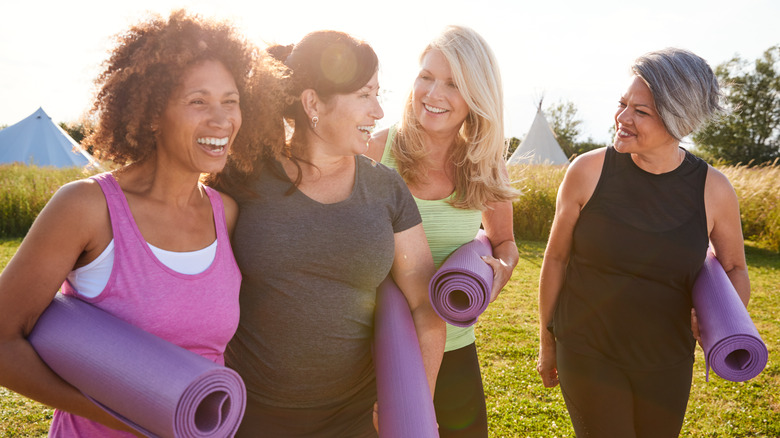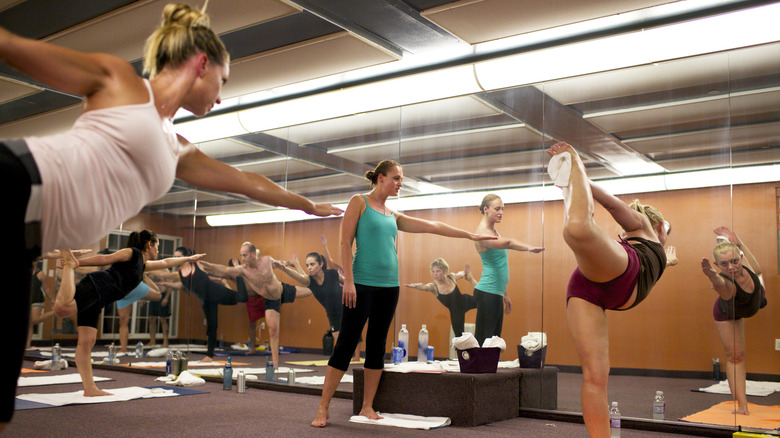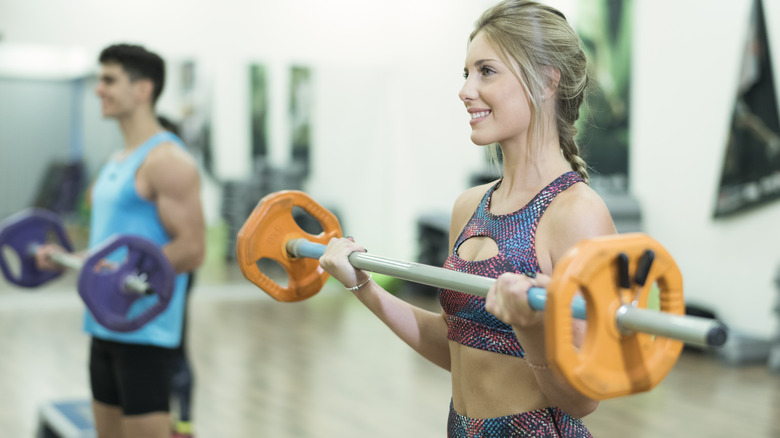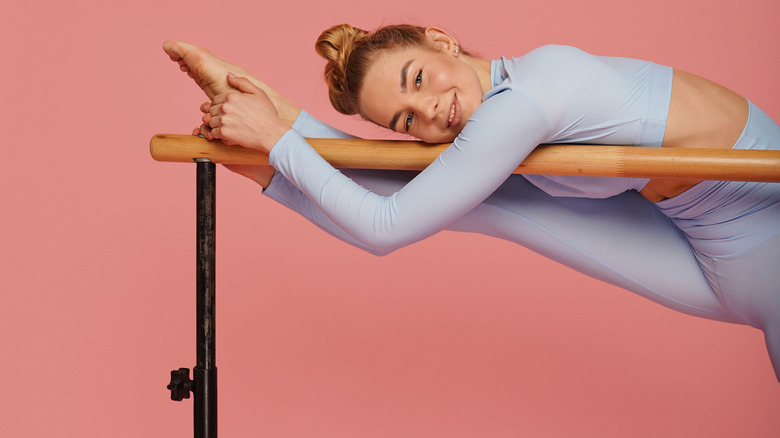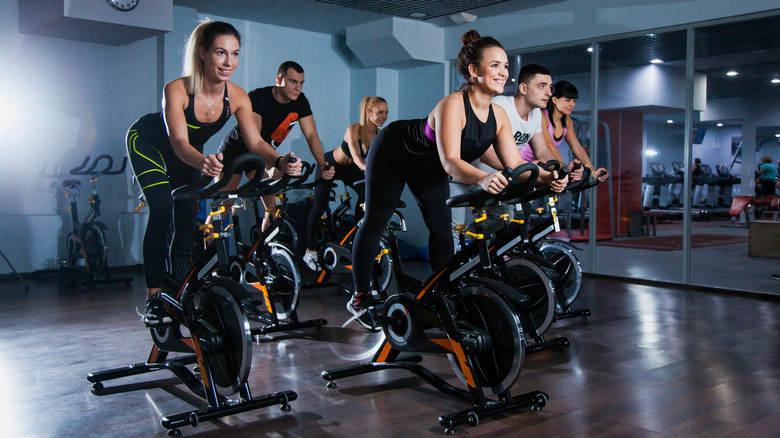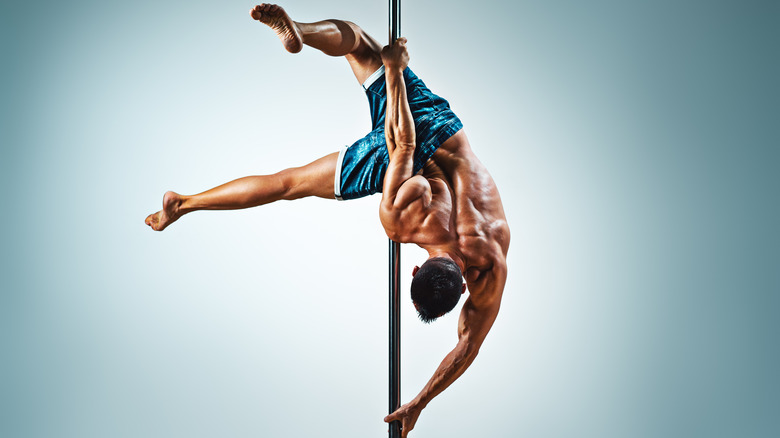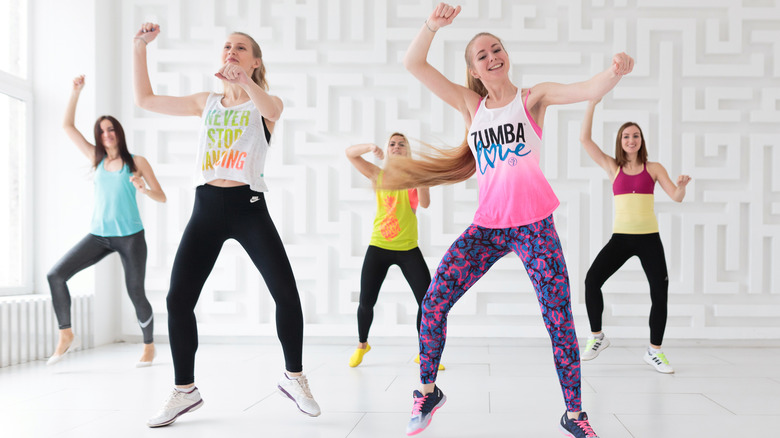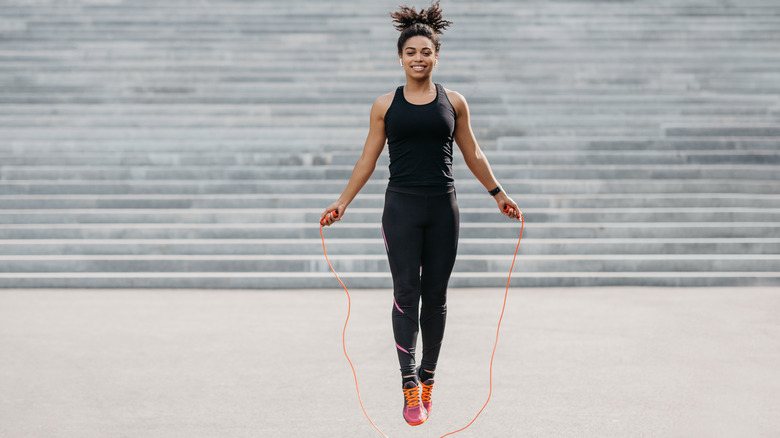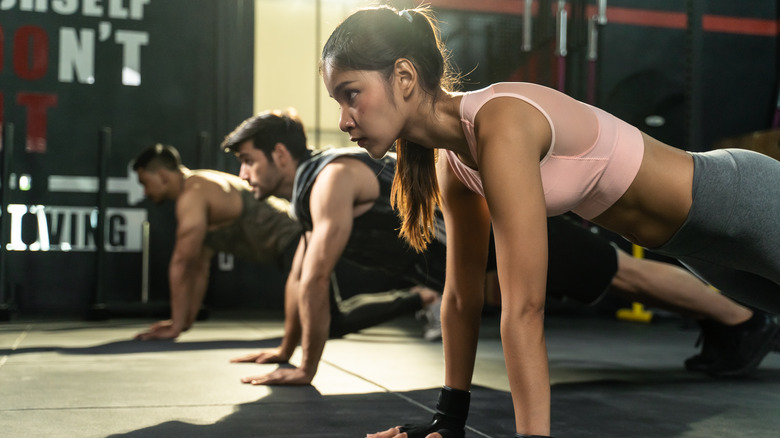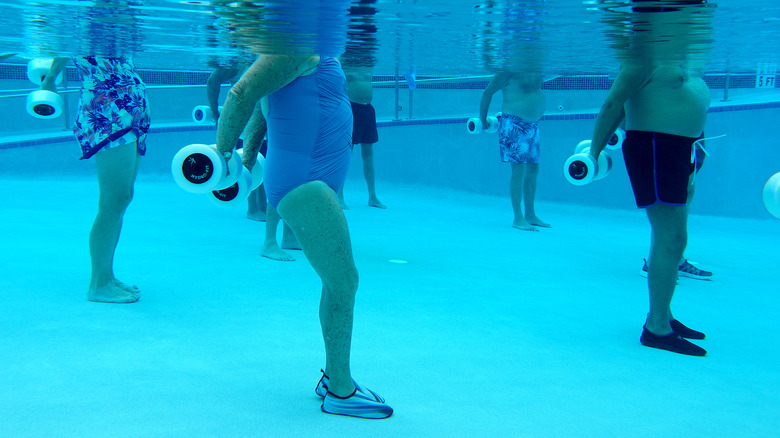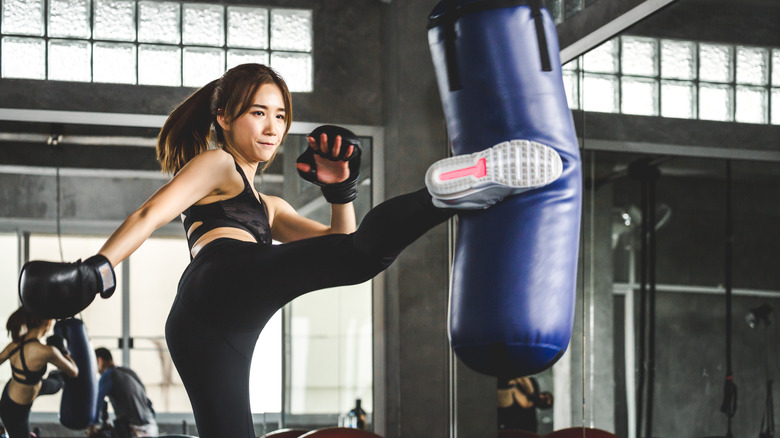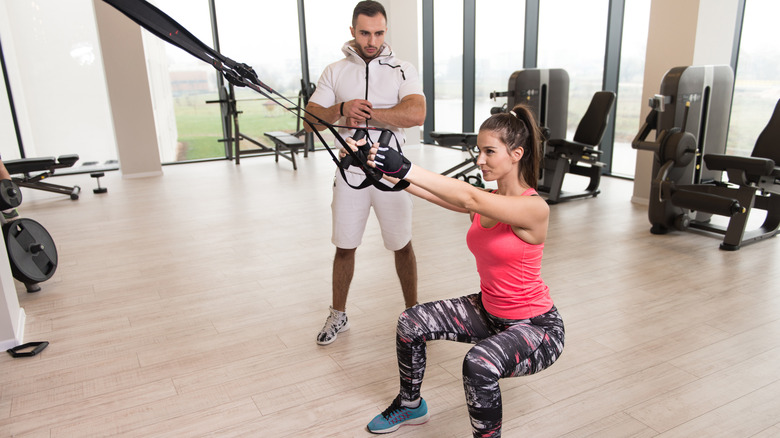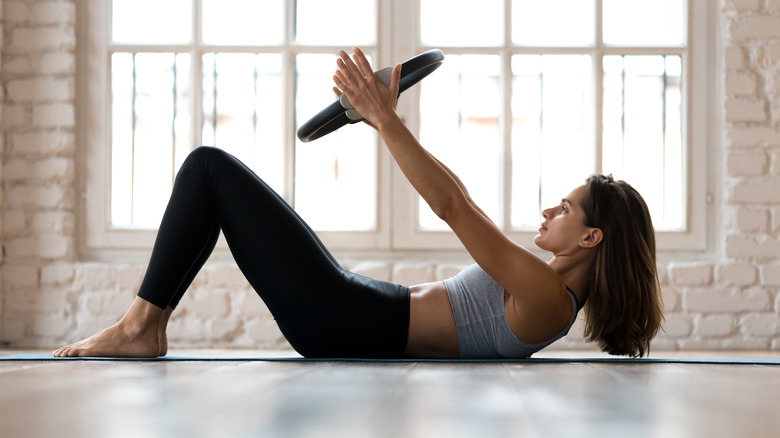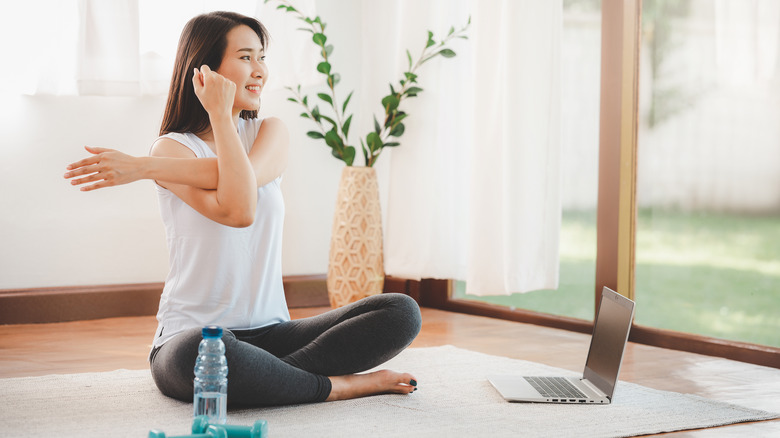Popular Exercise Classes, Ranked Worst To Best
If you have spent any amount of time soaking up the energy and wonder of group fitness classes, you likely know that there is one universal truth when it comes to popular group exercise classes: Not all group fitness classes are created equal.
While this is sometimes the fault of the instructor, some group classes are simply not as good as others for a variety of reasons. Group fitness classes are a great way to break a sweat with a community. Over time, regularly scheduled classes attract the same people, which feeds into a communal sense of accountability as well (via Men's Health).
Under the right tutelage, most fitness classes are not inherently bad. So we ranked these routines based on how complete and efficient they are while keeping a keen eye on the risk of injury in each class. We know you're busy and obviously wanting to avoid injury, so the parameters and metrics by which we ranked each class take that into consideration. Here are some of the most popular fitness classes, ranked from worst to best. Armed with this information, you'll be better able to decide which group exercise classes are the right fit for your body, goals, and lifestyle.
Bikram yoga
Bikram yoga was born of chaos, scandal, and a desire for money and perhaps world domination. Bikram Choudhury's sexual harrassment candals aside, practicing yoga in a heated room raises red flags among exercise professionals and traditionally-minded yogis alike (via Healthline). Beyond just the heat, the Bikram style of verbally cutting down and berating practitioners and aggressively encouraging them to move beyond their physical limitations is downright dangerous, not to mention demeaning.
At its core, yoga is meant to gently promote the movement of energy, or prana, throughout your body. Traditionally, yoga was used as a practice to heat the body up before engaging in a seated meditation. Bikram cherry-picked a handful of yoga poses that he believed to be the best and convinced his devoted followers to practice them with ferocity in a 105-degree room. In many cases, Bikram yogis allow their body temperatures to climb to 103 degrees, which is just one small degree away from 104 degrees, a dangerously high body temperature. The risk of over-stretching your heat-pliable muscle fibers is great and can lead to severe injury.
Since yoga is fairly gentle on the body by nature, participating in Bikram or other versions of hot yoga does not necessarily equal a physiological disaster. However, heated exercise classes need to be approached with major caution.
BODYPUMP
BODYPUMP is polarizing for a few reasons. Les Mills, the larger fitness company in charge of BODYPUMP, created the concept of "Rep-Effect," and strongly claim that this style of lifting weights is the "ultimate" when it comes to calorie-burning prowess. The idea behind this is that lifting lighter weights more quickly to increase the amount of reps you'll get in yields "more meaningful results." However, studies have repeatedly shown that lifting heavier weights to failure, or to near-failure, is the best way to build strength (per Stronger Tomorrow). Additionally, a light-weight, high-rep scheme can actually create "bulk" without substantial strength gains, which is often the antithesis of what people go to BODYPUMP for.
It's worth noting that Les Mills published their self-funded/conducted study on this using one specific rep speed. However, this is not the only rep speed utilized during BODYPUMP classes. In fact, the tempo often varies greatly, so it isn't totally sensible to base the effectiveness of a workout on a rhythm that is not maintained throughout class. Compared to more traditional cardiovascular workouts, BODYPUMP isn't as efficient when it comes to increasing your cardio work capacity.
In a group setting, it can be difficult for fitness instructors to correct everyone's form individually. This means that your form has to be dialed in to avoid falling victim to injuries. Ultimately, taking a BODYPUMP class is better than doing nothing. But if you have the time to dial in a more effective fitness routine, that would be better.
Barre
Barre is a great class and your risk of sustaining an injury as a result of taking a barre class is incredibly low. Taking barre classes regularly can help you build balance, core strength, and help you increase your flexibility. The movements employed in barre are hard enough to create a challenge (sometimes deceitfully), but not aggressive enough to scare away new exercise enthusiasts. Most of the common barre moves are scalable as well, which is part of why barre appeals to such a side variety of people. No matter your level of fitness experience, you'll find something to make your little muscles quiver in a barre class...
Unfortunately, the main downside of barre is that many of the movements do not encourage functional fitness, which is the type of fitness you need for strength in your daily life. Beyond lacking gross muscle movements and the subsequent strength-building side effects, barre does little to tax your cardiovascular system (via WebMD). The components generally recognized as the foundation of fitness are strength, flexibility, and endurance. Occasionally, balance will be thrown into the mix as well. Barre fitness does not work each of these systems to their optimal capacity (per National Institute on Aging). Ultimately, there is a time and a place to incorporate barre, as it is a wonderful way to further connect with your body. However, the components of fitness that barre lacks it make it a less-than-effective group fitness option.
Spin
Alas, spin class – an ear-drum-busting favorite and cult-following-building fitness class. Some people treat spin classes like they are the end-all, be-all when it comes to fitness, but they are mistaken. Spin is great, especially if it is a group fitness class that keeps you motivated and excited to reach your goals. The cardiovascular benefits of engaging in regular spin workouts are pretty prime. However, neglecting to incorporate more variety can sabotage your fitness goals.
In order to reap the benefits of spin class, you need to have your bike correctly set up and maintain proper posture and engagement throughout the entirety of the class. Even still, your glutes, which are a major lower body powerhouse, do not engage to their full capacity during indoor cycling. If spinning is your only form of exercise, avoiding full glute engagement long-term can wreak havoc on your posture and strength. If you maintain proper spinal alignment and posture, spin class is a fun way to get your sweat on, but if you're looking to spend your hour of "you time" getting a full body workout, there are more efficient options (via Live Strong).
Pole fitness
Pole fitness finds itself at this juncture on the list for a very different reason than most. Engaging in pole workouts has been known to blast your core strength to infinity and beyond. In fact, according to Mind Body Green, many pole dancers find themselves in the best shape of their lives as a result of the work they do in studio. Pole workouts are often full body workouts that require persistence, tenacity, and oodles of strength to pull off.
Pole fitness is difficult to rank because of the controversy surrounding it. In many circles, pole dancing is still considered to be taboo because of the sexual connotations surrounding it. That, when combined with the fact that pole athletes need to have bare skin in order to execute their stunts, continue to perpetuate the notion that there is something inherently "dirty" about pole dancing and pole fitness, specifically. Many people have reported that pole fitness has helped them heal from sexual traumas, find self-love and empowerment, and truly push the boundaries of what their bodies can do.
Since pole dancing still is shrouded in controversy, steer clear if you are looking to talk loudly and proudly about your new fitness routine (you know, like everyone who does CrossFit). When it comes to fitness, though, pole fitness is an awesome class that is sure to get your heart pounding and your muscled flexing (via Healthline).
Zumba
Zumba is yet another highly engaging and fun group fitness class that tends to draw a crowd of devoted followers. The relatively-easy-to-follow dance moves and addicting beats entice newbies and veterans into returning to class again and again. Zumba's milkshake brings all of the fitness enthusiasts to the yard gym, but like many other classes that are on this list, participating in only Zumba isn't the most effective workout out there. To be clear, participating in Zumba is a fantastic way to get moving, especially if you are new to exercise. However, it is beneficial to speak with an exercise professional to determine if doing Zumba day in and day out will help you reach your fitness goals (via Verywell Fit).
Zumba offers good cardio benefits, but not as much when it comes to strength building. Moreover, since it can be a high-impact workout, some people may have perfectly valid concerns related to shimmying and jumping too often. If you listen to your body and can incorporate some strength and flexibility building extracurriculars, Zumba is a fun and accessible way to break a sweat and get moving without downing three margaritas first.
HIIT
HIIT stands for high-intensity interval training, a style of workout that is known to spice up your fitness routine while yielding pretty impressive results. The world of efficient workouts wouldn't be the same without HIIT classes, but that doesn't mean that this style of workout is flawless. HIIT workouts deliver a potent combination of cardiovascular and strength-building work, which is the main reason that they are so effective in nature. These workouts have been shown to improve your endurance, strength, and fat-burning capacity. HIIT workouts allow you body to continue burning extra calories even after you complete your sweat sesh, which further aids in you goal-reaching abilities (via Sycamore Health).
Since HIIT is high-intensity, it should be incorporated into a well-rounded fitness routine. But it doesn't look quite as good if it is the only style of exercise you participate in. This is because the high-intensity elements can tax your body by increasing your risk of injury and add stress to your nervous system. Overuse injuries as a result of moving quickly through movements can happen, especially when they are performed repeatedly. Since this style of exercise can increase your levels of stress hormones, Sycamore Health recommends balancing HIIT with a lower-impact, more chill activity so you can reap the maximum benefits from both. The final con when it comes to HIIT workout classes is that some of the movements might not be well-suited for everyone, which narrows the population that can benefit from this style of training.
Boot camp
Boot camps are incredibly popular and only becoming more so. After all, more and more people are denouncing traditional #gymlife after COVID lockdowns showed us that we can work out effectively anywhere at any time.
Boot camp classes are similar to HIIT classes, but with a few notable differences. One of the main differences is that boot camps are easier to scale and can be structured in a low-impact way. This helps reduce the risk of injury, overuse and otherwise, when compared to HIIT workouts. Boot camps often utilize body weight movements, which is part of what makes them so accessible and pop-up worthy. The built-in community element creates a natural accountability that can lead to increased motivation (via Verywell Fit).
Much like HIIT workouts, one of the goals of boot camp is to make your heart rate ride peaks and valleys throughout the duration of the class. While this is incredibly efficient in terms of building a stronger fitness base, it can increase the stress hormones in your body, which can lead to inflamed conditions if left imbalanced (per Sycamore Health). Additionally, depending on the size of the boot camp crew, the exercises might not be individualized enough to support your goals.
Water aerobics
Honestly, what sounds better than exercising your way through your day while submerged in a body of warm-ish water? This is the stuff that fitness dreams are made of, people. Enter water aerobics (even though it is not always done in warm water). Water aerobics is one of the best ways to workout if you have arthritis, want a super low-impact option, or have complications that impede your mobility. Water aerobics can definitely scratch the itch when you're in the mood for a low-impact workout that leaves you feeling refreshed while also increasing your body's ability to torch calories (via Live Strong).
The main drawback of water aerobics is that since it is virtually no impact, it does little to increase the strength of your bones. Your bones grow stronger as a result of weight-bearing activities, of which exercising while submerged in water is not one. Even when weights are incorporated, water aerobics lacks the gusto to build muscle mass effectively. Gravity is one of the main components that assists us when we want to increase strength, and working out in water essentially removes gravity from the equation. The therapeutic benefits may outweigh the cons when it comes to water aerobics for you. Plus, the risk of injury is super low — you'll just have to be aware of any skin rashes that might occur as a result of the pool chemistry (via Live Strong).
Boxing
What?! How did a workout chock-full of punching and kicking things work its way to this lofty position on the list?
To clarify, we are not talking about fist-to-fist body contact boxing here. When boxing is done on bags on in a cardio-kickboxing style, it can be an exceptionally well-rounded and beneficial workout. The risk of injury is pretty low when you consider that you won't be getting hit in the face repeatedly, so that is cool. The constant changes and adjustments in the directions of your movements can help supercharge your cognition, agility, and proprioception.
By bending your knees and swinging punches with a strong core, you are able to access and work the majority of the muscles in your body. The upper body movements contribute to strength building while the pacing of the movements can increase your heart rate and help build your endurance capacity. Since boxing is weight-bearing, it can contribute to helping you build a strong skeleton, which can reduce your risk of certain diseases and health complications as you age (via Harvard Health).
TRX
TRX is a creative acronym that stands for total body resistance exercise — and frankly, it rocks. TRX classes can provide a full body workout and yield epic strength gains, no iron-pumping necessary. Since your center of gravity and core shift a ton during the course of a TRX class, your body's ability to maintain balance through proprioception is constantly challenged. This effectively lights a fire in the muscles that comprise your core and can lead to huge strength gains. TRX workouts are customizable because you can change the amount of effort needed by adjusting the placement of your hands and feet in space.
The back-to-basics approach increases the accessibility and ease in which TRX workouts can be performed. A standard TRX workout includes the following elements: a push, a pull, a squat, a hinge, a lunge, a rotation, and a plank. The biggest con when it comes to TRX workouts is that the demands imposed upon your lower body are limited to your body weight and any type of plyometric move you choose to include. Because of this, the amount of heavy lifting you can do with the lower body on a TRX is pretty limited. Even still, TRX is a fantastic and safe group fitness class for rookies and exercise veterans alike (via Verywell Fit).
Pilates
Pilates is an often-overlooked group fitness class that deserves a moment in the spotlight. Its creator, Joseph Pilates, derived this method as a way to help support proper posture and utilize deep stabilizing muscles to their maximal capacities. Pilates incorporates breath work, neuromuscular connections, and flexibility as it works to help realign your body's nature posture and structure.
Namely, Pilates increases your core strength, which can lead to improved posture, a decrease in pain and hip pain, and a lessened inclination towards future injuries. Your flexibility and mobility will increase with a regular Pilates regimen and so might your energy, as the breath component can increase the flow of blood (and thus, oxygen) throughout your entire body.
The risk of getting injured while enjoying Pilates is incredibly low, and there is something for everyone in a standard Pilates class. After all, who wouldn't benefit from a safe workout that improves balance, can boost your mood, and help you sleep better? That's what we thought...
Vinyasa and Hatha yoga
Yoga, sans Bikram, is the best group fitness class of all time. Yoga improves your strength, flexibility, and muscular endurance, of course. But those are just the components of fitness that it touches. Engaging in a consistent yoga practice has been shown to help improve your mood and mental health while decreasing the amount of stress you feel. Yoga can help reduce anxiety, and also has been linked to decreasing inflammation within your body.
Yoga is a gentle way to work your body without overtaxing many of your internal systems. By moving through your poses with deep, intentional breaths, your body and fitness levels will improve. So will your sleep, self-confidence, and even the health of your bones!
Yoga has the capacity to work every muscle in your body from a place of compassion, not aggression, which can help you maintain yoga as a part of your routine. And finally, so long as you listen to the cues of your own body, your risk of getting injured in yoga class is really low (via Healthline).

